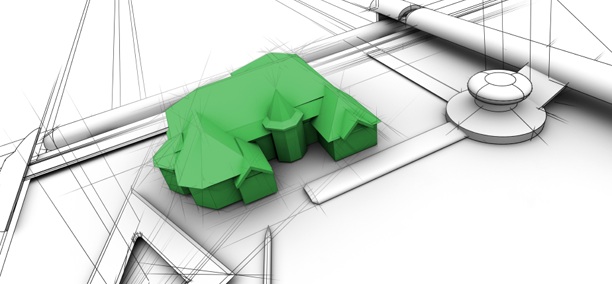Sustainable Homes of the Future: Green Building Principles
Bob Gorman August 4, 2015Sustainability, going green and lowering carbon footprints: these are all buzzwords that are gaining more attention and popularity both in the building industry and in the arena of public discussion. The astounding advances in technology over the past few decades have increased our everyday need for, and consumption of energy. Electric energy is the driving force behind our global economy, but its production is wreaking havoc on the environment and fast depleting our very limited non replenishable natural resources. Change starts at home, quite literally, and home construction experts are working hard to build homes that are environmentally friendly and energy efficient while providing all of the amenities and comforts modern man has come to expect. When building green, there are a few areas one must focus on.
Site Selection
The first step in constructing any building is prudent site selection, and the same is true for green homes. There are a wide variety of factors that should be taken into consideration, such as the impact on the environment, security, accessibility and if there are any existing structures that can be used or repurposed in your project. A methodical site selection is a good site selection, and it is best to address this issue at the very beginning of your project. Make a list of requirements, and keep them in mind when deciding on a build site. Ideally, your site of choice should be in an existing development zone where there is ample existing infrastructure, so you can keep both costs and environmental impact low.
Your lot is not only the future site of your green home, but might also have importance as a natural habitat. A sustainable home is one that does not upset the natural surroundings, so if necessary consider incorporating wildlife corridors into your design and linking natural areas as much as possible. Check the site for erosion risk, so that you can be prepared for possible landscaping erosion control practices.
Sustainable Materials
Now that you have decided on a building site, the next challenge is to choose your building materials. Using repurposed, recycled and biodegradable materials is a surefire way of making your home environmentally friendly. Repurposed wood, for example, not only puts a dent in deforestation levels, but also gives your home a unique and distinguished look.
When choosing paints, adhesives and other chemicals that are vital in home construction, opt for biodegradable options that contain no VOCs (Volatile Organic Compounds). They do not harm the environment while at the same time making for a healthier, non-toxic, living space. For “earth materials” such as stone, brick and soil materials, try using what is locally available. The advantages are multifold: you reduce transportation related energy costs, thus bringing down both your build costs and environmental impact as well as supporting local businesses and resource bases.
Low Energy
To be sustainable, a home needs to be as close to off the grid as possible. This means relying on renewable sources of energy, such as solar and wind power. Although initially costly, investing in renewable energy will save you a lot of money in the long run. Lighting accounts for roughly 15-20% of the power consumption of a conventional house. Using LED lighting and light fixtures instead of incandescent bulbs will significantly reduce this percentage.
A large amount of energy is lost due to insufficient insulation, through windows, doors and ultimately the roof. Low-emittance windows have a special metal oxide coating that keeps the house warm in winter and cool in summer. Specially designed reflective tiles ensure high solar reflection to ensure less heat absorption. Another answer to roof insulation is quite literally a green roof: a garden on your roof surface that acts as great isolation while helping to keep the air clean.
Water Management
In just one year, buildings use more than 15 trillion gallons of water, which is roughly 14% of the world’s potable water. Efficient and economical water supply and reuse systems are vital if we want to avoid a worldwide water crisis. Low flush toilets and water efficient faucets are a step in the right direction, as is rainwater collection, graywater reuse and on-site sewage treatment. A green home lets no water go to waste, as the water management system reuses water multiple times for various functions. For example, water runoff from the kitchen and bathroom can be reused to water gardens, and this water in turn can be filtered for use as greywater.



